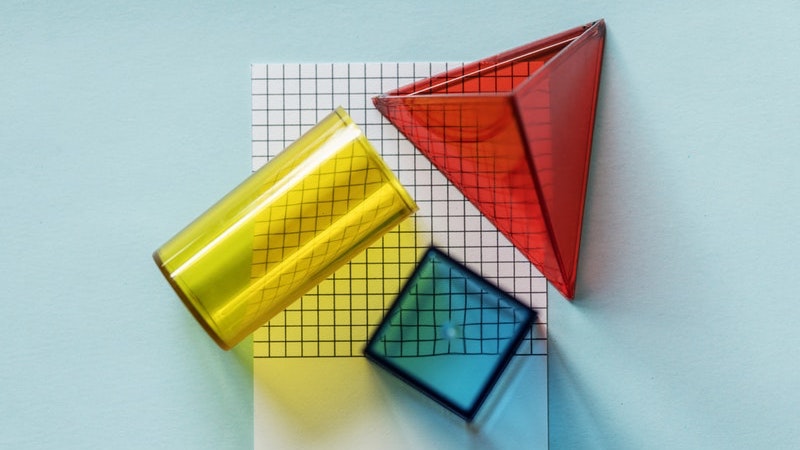Geometry
Episode #5 of the course Everyday math by Jenn Schilling
Welcome to Lesson 5 of Everyday Math! Today, we’ll learn more about geometry, which is a wide field of mathematics covering everything from lines and angles to multidimensional shapes. We will focus primarily on aspects of two-dimensional and three-dimensional shapes.
The Math
Two-dimensional shapes are flat shapes that can be represented on a piece of paper, such as a rectangle, triangle, or circle. Three-dimensional shapes have length, width, and height and can be represented as a solid shape. All shapes have properties concerning the lengths of their sides and the measurements of their interior and exterior angles.
When working with two-dimensional shapes, it is often useful to understand the perimeter and area. The perimeter is the distance around a shape. For example, a rectangle has a length and a width; the perimeter of a rectangle is found by adding together two lengths and two widths (length + length + width + width). The perimeter of any polygon (a two-dimensional closed shape with straight edges) is the sum of its side lengths. The perimeter of a circle is slightly more challenging to determine; it involves the mathematical constant π (Pi). The formula for finding the perimeter of a circle is twice the radius multiplied by π (or 2πr).
Area tells us the size of a shape or surface. There are different formulas for area based on the type of shape, but in general, knowing the formula for the area of a rectangle and the formula for the area of a triangle will tell you what you need to know because complex shapes can often be broken down into rectangles and triangles. Once you find the areas of the rectangles and triangles, you simply add all the areas together to find the area of the complex shape. The area of a rectangle is the length multiplied by the width (A = l × w). Because a triangle is 1/2 of a rectangle, the area of the triangle is 1/2 of the product of the base of the triangle and the height of the triangle (A = 1/2 (b × h)). The area of a circle once again requires the use of π, it is π times twice the radius squared (A = π × r2).
Three-dimensional shapes have an additional component, their height or depth. This additional dimension allows us to calculate the volume of these shapes. Volume tells us how much the solid could hold. We can also calculate the surface area of solids, which tells us the size of all the shape’s surfaces. Volume and surface area formulas are dependent on the specific type of solid, and solids cannot be broken down so easily into simple shapes. However, these formulas are easy to look up as needed.
Everyday Applications
Two-dimensional and three-dimensional shapes show up in many everyday applications, including home improvement and baking.
When planning a home improvement project such as painting or flooring, it is important to understand the area of the wall or floor in order to purchase the correct amount of materials. Floors and walls are usually polygons that can be broken into rectangles and triangles in order to find the area. When planning fencing, flower beds, or other outdoor garden borders, the perimeter of polygons becomes useful to determine the necessary quantities of supplies. By adding up the sides of the space, you can calculate how much material you will need. Any building project will require both two-dimensional and three-dimensional geometry in order to accurately create a space and obtain the required materials. Any garden feature that requires filling (such as a pool) will necessitate volume calculations to ensure the correct quantity of water or other material is ordered.
In baking, surface area is useful for determining the quantity of ingredients needed. For example, when icing a cake, it is important to know how large a surface you will need to cover. When scaling a recipe or determining the appropriate pan/dish size, it is important to understand volume, as well as surface area, to ensure that the selected cookware will meet the quantity of ingredients. Perimeter is also a useful calculation in baking, as decorations on cookies or cakes can be placed around the edges of the baked goods.
We’ve only touched the surface of geometry and its applications in our lives; it can also be found in building, furniture, design, sewing, and fashion.
Congratulations on making it halfway through the Everyday Math course! I look forward to seeing you tomorrow, when we discuss the all-important number sense.
Share with friends

